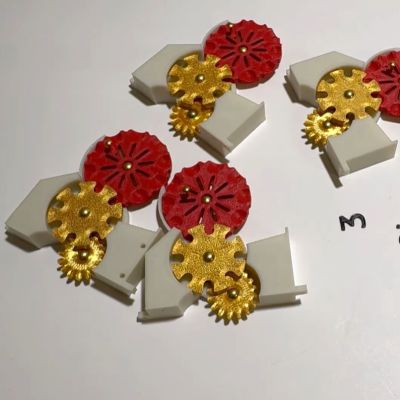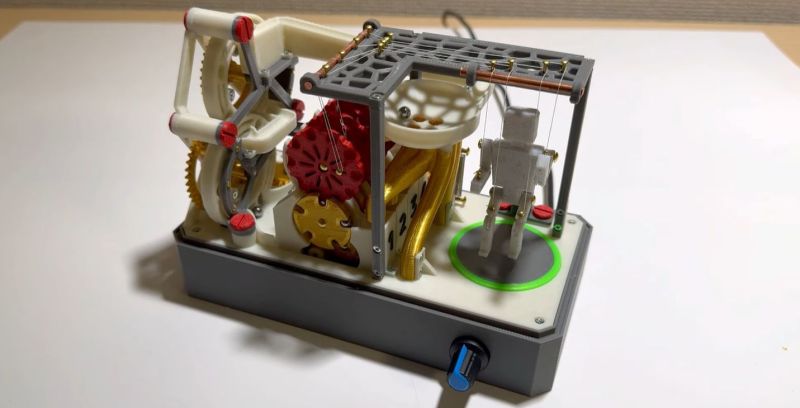
Over the years we have seen many marble machines, but this one on the [Karakuri channel] (hit CC for subtitles) on YouTube is somewhat special, as it uses Geneva drives to turn the motion of the steel balls going around the circuit into random movement of a marionette. The Geneva drive type of gear mechanism normally converts a constant rotary motion into intermittent rotary motion by having a singular pin on the first wheel drive the second wheel. In the demonstrated mechanism, however, the pin is replaced by the steel balls, which are only intermittently and randomly present because of how each steel ball picks one of four paths, one towards each Geneva drive.
As a result of this, the motion of the marionette’s appendages – attached to the red wheel – is random. The only powered element of the (mostly 3D printed) system is the drive mechanism that carries the steel balls up again and keeps the primary wheels on the Geneva drives rotating. We have to give the creator pops for what is both an interesting art piece and a demonstration of how to creatively use this somewhat unusual gear mechanism to introduce randomness without a lot of complexity.
Thanks to [MrTrick] for the tip.

















This is delightful.
how does it know how to reverse the direction of travel of the limbs when it they are at the limit.
looks like the strings are tied to pins on the red gears and are tightened and then loosened as they rotate with the pins being closer or farther away from the pulley point, essentially acting as cams.
Strings are attached to a pin offset from the center of each red wheel. So each limb moves within a specified range equal to 2x the radial offset of the pin.
It doesn’t, the red wheels keep rotating in one direction but the threads get more slack on the way back. In the end sequence the front red wheel is at the bottom but at 17:47 it starts to rotate “back”.
Except, what she shows in the video is not a Geneva mechanism. The Geneva mechanism locks the output shaft in place between advancements, while in the mechanism she shows, the output is free to turn whenever there is no ball in the channel.
There’s a plastic leaf spring and detents on the outer edge of the red pieces though, so the output is held in place between movements.
KARAKURI is up there with Robert Murray-Smith, Cody’s Lab, and LIMONE Workshop (리모네공방) as good hacker comfort-video. They are a treasure.
RMS always seems to be hovering very close to the free energy / endless wacky but ineffective wind/hydro generators fringe of things – he features some interesting stuff but always seems a lot more optimistic about unconventional designs than someone thinking critically maybe should.
I like his videos as a seed for brainstorming/idea generation sessions. He shows all sorts of obscure battery chemistries you can potentially make at home and all of the wacky wind stuff as you say. He flits about too much though. I do somewhat think he’s on need of one project to carry from start to finish and make a video series about. Build a small home wind turbine with battery storage made from scratch including the batteries, something like that would be pretty compelling to me.
I think you my be coming at this from the wrong end of the barrel, friend. He does present this stuff in a friendly-seeming format, but when it’s possible for him to do so he always goes to a model and tries to show this innovative method’s performance, or lack thereof.
Now, imagine you have a friend who’s _very_ hopeful about this stuff, to the point of indulging woo almost compulsively. You send them to RMS, and within a few weeks they’re still hopeful, but far clearer on what sorts of things can be done. RMS rarely, if ever, makes it look like he’s attacking the inventors of the marginal stuff, but his enthusiasm rarely goes over the line to treating this stuff as world-changing.
I love the use of brass nails as axles! This is brilliant.
It’s a great piece, I like it!
But… I would have considered it art if it was handmade from metal, and fully ornate and polished, and just beautiful to look at and function as a centerpiece. But now it just looks like a proof of concept to me. Unless it’s really a proof of concept and an art piece will follow out of it, I think it’s a pity. Go for it!
At what level of tool use does a project start to become “Art”?
LOL
Nothing is ever good enough…
Who has a gear-cutting lathe?
Have you ever seen airplanes made from old soda cans? Those folk have many skills, both physical and imaginitive, where most folk are lucky to have just one.
Folk today can do amazing things, with amazing skill, on computers, and be lost to bit-rot. Now those same folk can bring their amazing virtual skills into reality.
But for you, that’s not good enough. They should have amazing skills, in numerous fields, otherwise it’s not art to you.
Way to set the bar past high to dang-near humanly-impossible.
Sheesh.
Hear hear!
I must politely disagree with your assessment of this creator’s works as to whether they’re art or not. KARAKURI very intentionally invokes the style of mechanical toys, especially those by Tomy and other Japanese toymakers, from the era just before the explosion of consumer electronics being used in children’s toys.
In the late 70’s and early 80’s all of these parts would have been precisely injection molded and hand-assembled in a factory. Obviously, it wouldn’t have used the stepper motor and arduino-like. A commercial product of the era would have probably used a wind-up system or maybe a C-cell and simple DC motor.
I think we agree that the primary draw of the item is in its design. In that it is more craft than art. But, the attempt to adhere to a specific style from a specific time and place really makes some of the design choices seem to be made for aesthetic purposes, i.e. art.